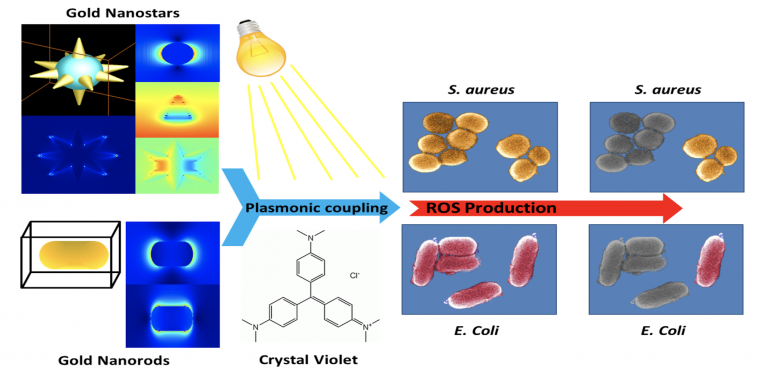New publication in ACS Applied Bio Materials for Thanh Lab
2 January 2020
A Study of the Effect of Anisotropic Gold Nanoparticles on Plasmonic Coupling with a Photosensitizer for Antimicrobial Film.

Emergence of drug resistant bacteria has been one of the main concern for the public health in the recent times, especially for the treatment of the infection acquired in hospitals, where accidents breaking the sterility may expose a debilitated patient to the contact with bacteria that have grown resistant to the main antibiotics. Because bacteria can growth resistant to most of the drugs, it is necessary to develop new methods to kill them that not require the use of drugs.
The plastic film described in this article utilizes super small gold particles shaped as rods (nanorods) or as sea urchin (nanostars) at the same time to a dye, crystal violet to kill the bacteria on its surface when exposed to light.
Gold have been chosen as material for the light harvesting nanoparticles; gold particles are not toxic for mammalian cells and have a great capability of absorbing light through their surface plasmon resonance (SPR). Furthermore, tuning their shape and dimensions was possible to match their light absorption with the one of the dye. Matching their absorption will enable the transfer of energy from the particle to the dye maximizing the production of oxygen reactive species (ROS).
When the system particles/polymer/dye is formed it enhance the generation of ROS to the point that the light of commercial tube light was sufficient to generate a bactericidal effect. The films showed great antimicrobial activity against gram negative bacteria (E. coli) in 4 h of light exposure, when modified with gold nanostars, it could kill E. coli in 5 orders of magnitudes (5-log) and the one modified with gold nanorods could kill with 4 order of magnitudes (4-log). While maintaining partial activity against gram positive bacteria (S. aureus), i.e. being able to kill in 2.5 orders of magnitudes by the film containing gold nanostars and 3 orders of magnitudes by those containing gold nanorods.
The differential response of gram (-) and gram (+) bacteria to the ROS generated by the films, was connected with the different structure of the two types of bacteria tested in this work. E. coliare gram (-) rod shaped bacteria with average size of 0.25 µm to 1.5 µm. It has a double membrane separated by a barrier and some interstitial space reaching a total thickness between 10 to 15 nm.The complexity of their outer membrane structure makes them resistant against oxidative and chemical stresses, limiting the amount of harmful substances reaching the internal and vulnerable parts of the bacteria. At the same time E. coliis able to reduce the damages caused by the contact with harmful substances deploying a series of defence mechanism and enzyme to reduce their toxicity. S. Aureusinstead is a spherical gram (+) bacteria with average diameter of 0.5 to 1 µm. These bacteria possessed only one thick external membrane composed by multiple layers of sugars and amino acids. This barrier could vary in thickness between 30 to 100 nm. The barrier of gram (+) bacteria was more permeable to chemical species and more resistant to physical stresses. To compensate for the permeability of their barrier these bacteria are able to deploy a combination of defence mechanisms to reduce and contain the damages caused by the contact with ROS (enzymes, reactive molecules and free ions) and convert them in harmless substances.
 Close
Close

